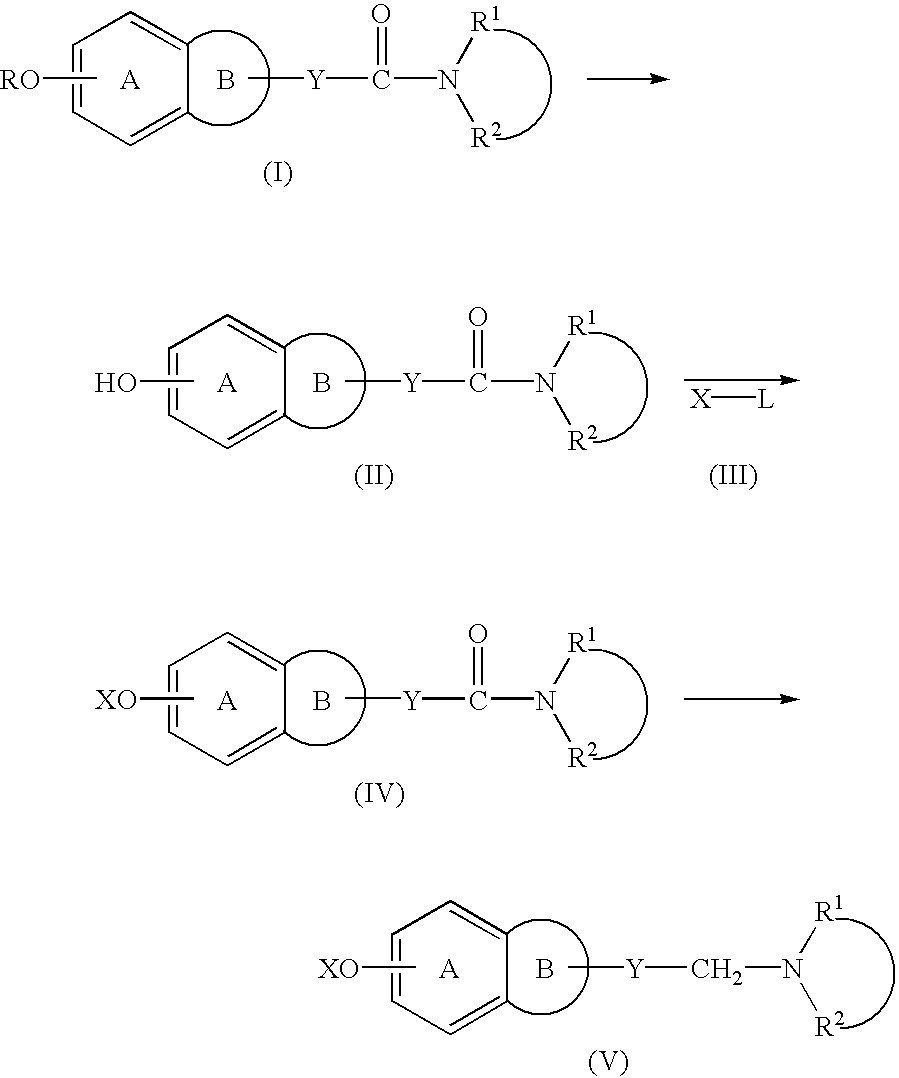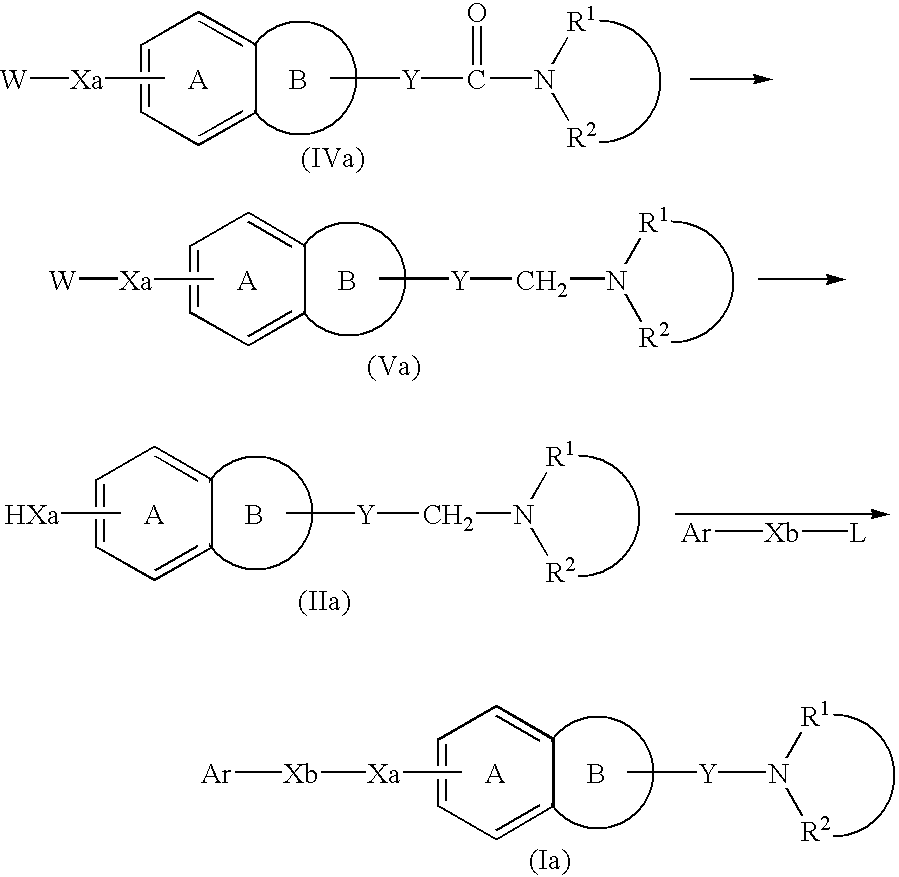Process for producing amine derivatives
a technology of amine derivatives and amines, which is applied in the preparation of carboxylic acid amides, organic chemistry, drug compositions, etc., can solve the problems of difficult selective cleavage of ether linkages, and achieve excellent stability, inhibit the production and secretion, and prevent and treat diseases.
- Summary
- Abstract
- Description
- Claims
- Application Information
AI Technical Summary
Benefits of technology
Problems solved by technology
Method used
Image
Examples
reference example 2
2-(6-Methoxy-1-oxotetralin-2-yl)acetic acid
1212 g of 2-(6-methoxy-1-oxotetralin-2-ilydene)acetic acid, 3636 ml acetic acid and 1357 ml purified water were mixed. 409 g zinc powder was added by small portions to this suspension, and the mixture was heated under reflux for 2 hours, and when the solution was hot, the zinc was removed by filtration. The vessel and the zinc were washed with 606 ml acetic acid of 80.degree. C., and 2885 ml hot water was added dropwise to the filtrate which was then cooled with water and stirred for 1 hour. The precipitated crystals were collected by filtration and washed 4 times with 1.45 L purified water. By drying it under reduced pressure at 50.degree. C., the title compound, 1173 g (yield 95.9%), was obtained as brown yellow crystals.
.sup.1 H-NMR (300 MHz, DMSO) ppm; 1.92 (1H, m), 2.12 (1H, m), 2.38 (1H, m), 2.72 (1H, m), 2.84-3.06 (3H, m), 3.84 (3H, s), 6.90 (2H, m), 7.84 (1H, m).
reference example 3
N,N-dimethyl-(6-methoxy-1-oxo-2-tetralin)acetamide
1170 g of 2-(6-methoxy-1-oxotetralone-2-yl)acetic acid, 7020 ml acetonitrile and 733 ml triethylamine were mixed. 645 ml pivaloyl chloride was added dropwise thereto at 5 to 10.degree. C. under a nitrogen atmosphere and stirred at the same temperature for 1 hour, then 611 g dimethylamine hydrochloride was added thereto, 1047 ml triethylamine was added dropwise thereto at 1 to 10.degree. C., and the mixture was stirred at room temperature. 3510 ml purified water was added to the reaction solution, which was then extracted with 14.04 L ethyl acetate, and the organic layer was washed twice with 3510 ml of 5% sodium bicarbonate and then with 3510 ml purified water. The organic layer was concentrated under reduced pressure such that the amount of the remaining solution became 3510 g. The remaining solution was crystallized by adding 2750 ml diusopropyl ether, and 6030 ml diisopropyl ether was added dropwise thereto and stirred for 1 hour ...
reference example 4
N,N-dimethyl-(1-hydroxy-6-methoxy-2-tetralin)acetamide
1056 g of N,N-dimethyl-(6-methoxy-1-oxo-2-tetralin)acetamide and 5280 ml methanol were mixed, and a solution of 198.8 g sodium tetrahydroborate in 1190 ml dimethylacetamide was added dropwise thereto at 5 to 20.degree. C. under a N.sub.2 atmosphere, heated and stirred at an internal temperature of 33 to 35.degree. C. for 2.5 hours. The reaction solution was cooled and neutralized at 5 to 10.degree. C. by dropping hydrochloricacid, then 5280 ml purified water was added, the reaction solution was concentrated under reduced pressure until its volume was reduced by about half, 5280 ml purified water was added to the remaining solution which was then concentrated again under reduced pressure such that the amount of the remaining solution became 5280 g. The precipitated crystals were collected by filtration, washed with 2020 ml cold water and dried at 40.degree. C. under reduced pressure, to give 870.8 g of the title compound as pale y...
PUM
| Property | Measurement | Unit |
|---|---|---|
| temperature | aaaaa | aaaaa |
| temperature | aaaaa | aaaaa |
| reaction time | aaaaa | aaaaa |
Abstract
Description
Claims
Application Information
 Login to View More
Login to View More - R&D
- Intellectual Property
- Life Sciences
- Materials
- Tech Scout
- Unparalleled Data Quality
- Higher Quality Content
- 60% Fewer Hallucinations
Browse by: Latest US Patents, China's latest patents, Technical Efficacy Thesaurus, Application Domain, Technology Topic, Popular Technical Reports.
© 2025 PatSnap. All rights reserved.Legal|Privacy policy|Modern Slavery Act Transparency Statement|Sitemap|About US| Contact US: help@patsnap.com



